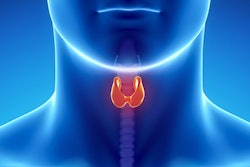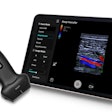Older patients may benefit most from active imaging and pathology surveillance of small, low-risk papillary thyroid cancer, according to research published August 20 in JAMA Surgery.
A team led by Anna Sawka, MD, PhD, from Toronto General Hospital in Ontario, Canada, found that more than three-fourths of patients who chose active surveillance via ultrasound and blood work continued this route in the absence of disease progression or other indications for surgery at long-term follow-up. The group also found that older patients continued with surveillance more often than younger patients.
"We were struck by how durable active surveillance was, particularly in older patients," Sawka told AuntMinnie.com. "The findings reinforce the central role of high-quality ultrasound imaging in safely monitoring small, low-risk thyroid cancers over time."
Active surveillance may be favored by some patients in managing low-risk, early-stage cancers. This makes counseling patients important, so they better understand how surveillance ties into patient age.
Sawka and co-authors evaluated the durability of active surveillance in patients with small, low-risk papillary thyroid cancer according to age at the time of choosing surveillance. The surveillance protocol included ultrasound exams performed in the joint departmental medical imaging department, blood work, and clinical assessment every six months for two years. This was followed by a yearly assessment if the findings were stable. The team reviewed medical records from patients at baseline and at least yearly and “made a concerted” effort to inform patients of their options.
For the study, the researchers focused on the overall rate of surveillance crossover to definitive treatment and the indications that led to crossover events.
Final analysis included 200 patients with an average age of 52 years, 155 of whom were under active surveillance and the remaining 45 of whom had immediate surgery. The team followed up with the patients for a median of 71 months. It reported no thyroid cancer-related deaths or any distant metastatic disease.
The overall crossover rate from surveillance reached 23.9% (n = 37), with 32 patients completing treatment, three declining surgery, and two awaiting treatment.
Crossover reasons included the following:
Disease progression (56.8%),
Patient preference (40.5%), and
Ultrasound imaging limitations preventing accurate tumor measurement under active surveillance (2.6%).
For the ultrasound imaging reason, the team highlighted that the tumor border in one patient with Hashimoto thyroiditis was not clearly distinguishable from heterogeneous echotexture of the thyroid parenchyma.
The investigators also noted the following rates for five-year age-stratified cumulative overall crossover incidence: 41.5% in patients younger than 45 years, 20.9% in those aged 45 to 64 years, and 5.1% in patients aged 65 years and older (p < .001).
They suggested that active surveillance may be offered as a first-line management option for patients with small, low-risk papillary thyroid tumors. This could be “especially relevant” for older patients who may want to avoid surgery.
Sawka said the results underscore the importance of precision imaging in supporting non-surgical management pathways for low risk thyroid malignancies.
"In our study, active surveillance outcomes were relatively comparable to immediate surgery in terms of overall cancer control," she added. "It is important to acknowledge that all patients in our study had thyroid cytopathology obtained by fine needle aspiration biopsy prior to enrollment, and the cytology was required to be either positive or suspicious for papillary thyroid carcinoma for inclusion in this study. In follow-up, ultrasound-guided biopsies were only performed if clinically indicated."
Sawka also told AuntMinnie.com that the team is continuing to follow this patient cohort as part of a larger, multicenter Canadian study.
"This will allow us to gather longer-term outcomes in a broader population base," she said.
The full study can be found here.




















